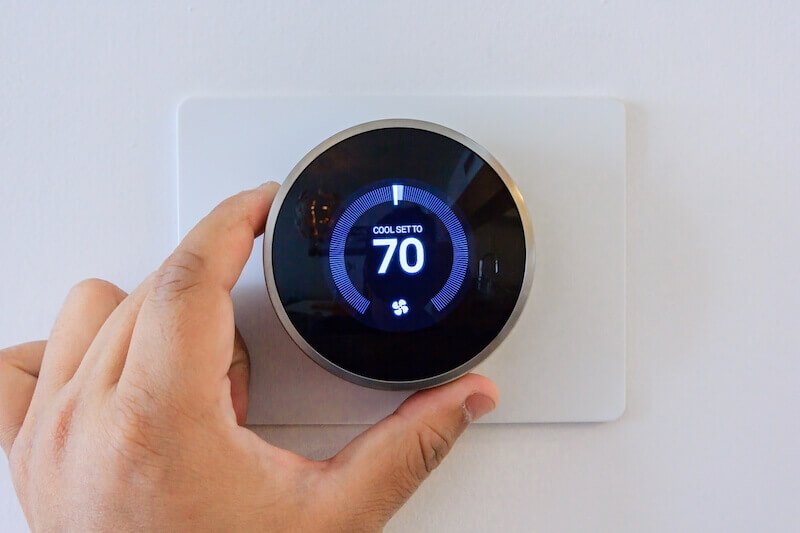As the cold winter air creeps in, it’s important to prepare your home for chilly days and nights. Preparing your central heating system for Winter is a crucial part of ensuring that you and your family can stay warm throughout the colder months. Think of it like putting on a cosy blanket when the temperature drops; just as wrapping up keeps us comfortable and safe, so too does properly preparing our homes!
No matter how intimidating winter prep may seem at first glance – don’t worry, the process isn’t actually all that hard once you break down each task into manageable chunks. A little bit of effort now can go a long way toward making sure that your family stays comfortably cosy during those frosty months ahead.
Prevent Cold Air With Draught Proofing
Draught proofing your home is essential for keeping it warm and efficient during the winter months. It’s important to check for drafts around windows, doors, walls, and any other possible places where cold air can enter. You’ll want to look for gaps in these areas – if you find them, seal them up with caulk or weather-stripping. Doing this will ensure that no cold air gets into your house when the temperature outside drops. Whilst running this check you may also like to check your window glazing – single glazed windows are pretty rare nowadays but if you do find that they are installed in your home then upgrading your outdated windows can be an excellent way to improve your home’s heat retention.
It’s also a good idea to get an energy audit done on your property. This will help identify any heat loss from insulation problems or air leaks within the home. A heating engineer can assess all of these potential sources of draught and suggest ways to improve efficiency. Having an expert come out and inspect your property can save you money on utility bills while making sure you stay comfortable throughout the colder seasons.
In addition to improving efficiency, draught proofing can reduce noise levels inside the home by blocking external sounds such as traffic or loud neighbours. Taking care of these issues now means fewer worries later down the line – not only do you benefit from a warmer environment but also peace and quiet!
Bleed Your Radiators
To ensure your home is as warm and cosy as possible, it’s important to bleed your radiators to improve your home’s heating efficiency. When air builds up inside the radiator, it prevents the heat from being evenly distributed throughout the radiator, resulting in inefficient heating.
Bleeding the radiator removes any trapped air, allowing the radiator to heat up properly and improving the overall efficiency of your home’s heating system.
To do this, turn off the boiler and locate the bleed valve at the top of the radiator. Once located, unscrew it with a flathead screwdriver or bleed key until the hissing stops and water starts dripping out – then quickly tighten up again.
Repeat this step across all radiators in your home for optimal performance. Here’s a quick checklist for easy reference:
- Turn off your heating.
- Use your radiator key to turn the valve at the top of the radiator.
- Attach the key to the square groove in the centre of the valve and turn it slowly anticlockwise.
- You should hear a hissing sound.
- Use your cloth to catch any water that comes out.
- Retighten the valve once the hissing stops and only liquid comes out.
- Turn your central heating system back on.
- Check the pressure by looking at the gauge on your boiler.
- If the pressure is too low, top it up using the lever or tap on your boiler, known as the filling loop.
- Check if your radiator is now heating up properly.
When completed correctly, these steps can help improve comfort levels while ensuring you get value for money on energy bills – both long term wins!
Use Trvs To Turn Off Radiators In Unused Rooms
One of the best ways to do this is by using Thermostatic Radiator Valves (TRVs) to turn off radiators in rooms that are not being used. TRVs allow you to control the temperature in each room independently, so it’s easier to manage overall heating costs.
When installing TRVs, make sure they’re correctly positioned near the radiator valve where cold air can’t reach them. This will help ensure accuracy with their readings. You’ll also want to check the pressure level of your boiler before adjusting any settings on a TRV as incorrect pressures can lead to inaccurate readings or potentially even damage the valves themselves.
Once everything’s set up and running properly, you’ll be able to reduce energy usage by only heating rooms when needed – saving money while still keeping your home nice and cosy! With proper use of TRVs, you can rest assured knowing that your heating system will be efficiently managed all winter long.
Update Your Insulation
Updating your insulation is one of the most important aspects of winterizing your heating system. It ensures that heat remains in your home, instead of escaping through walls and windows. Insulation helps to keep the temperature consistent throughout all parts of your house, so you don’t have cold spots or drafts.
When it’s time to update your insulation, there are a few key things you should remember. The first is to check for air leaks around windows and doors. If these areas aren’t properly sealed, then warm air can escape and cool air can come in from outside – making it harder for you to stay comfortable during the winter months. You can use caulk or weather stripping to seal up any gaps or cracks you find.
Finally, make sure that your existing insulation isn’t too thin or damaged. Over time, insulation breaks down and loses its effectiveness; if yours looks worn out, then it’s probably time for a replacement. Get some high-quality R-value rated material – this will ensure maximum efficiency when keeping the warmth inside your home!
Upgrade Heating Controls For Better Thermostatic Control
For many of us, the idea of a warm and cosy home is something that brings cheer to our winter days. To make sure your heating system works as it should, upgrading your heating controls can be an effective way to ensure you have optimal thermostatic control.
Smart thermostats have a range of benefits, particularly when it comes to energy efficiency. Here are some of the advantages of upgrading to a smart thermostat:
- Increased energy savings: Smart thermostats can be programmed to adjust the temperature settings based on the time of day and your household’s energy usage patterns. This helps to ensure that your heating system is running optimally and you are maximising your energy savings.
- Remote access: With a smart thermostat, you can control your heating system from anywhere with a smartphone or tablet, allowing you to adjust the temperature to the exact setting you need from the comfort of your own home.
- Easy-to-use interface: Smart thermostats have a user-friendly interface that makes it easy to adjust the temperature settings quickly and easily.
- Improved safety: Smart thermostats can detect potential safety issues such as carbon monoxide and alert you if there is an issue.
- Eco-friendly: Smart thermostats help reduce energy consumption, which is better for the environment.
Upgrading to a smart thermostat is an easy way to maximise your energy savings while ensuring that your heating system is running efficiently and safely. By taking advantage of all the benefits that a smart thermostat has to offer, you can keep your home comfortable and reduce your energy costs this winter.
Conclusion
Following these five essential tips for winterizing your heating system will keep you and your family warm all season long.
The first step is to draught-proof any areas of your home where heat may be escaping. This simple step alone could potentially save up to 10% on energy bills! Next, make sure to bleed your radiators so they’re working at their most efficient level. If there are rooms in the house which don’t need warming then turn off the radiator using thermostatic radiator valves (TRVs). It’s also important to update insulation levels in attics and walls – this could reduce energy costs by as much as 25%. And finally, upgrading heating controls with modern systems such as smart thermostats or wireless room sensors can result in an energy saving of around 26%.
In summary, taking just a few simple steps now can help ensure that you stay comfortable and cosy throughout the entire winter period – while reducing energy bills too! An estimated 90% of households still rely on traditional methods when it comes to controlling home temperatures – but now is the perfect time to switch things up and start seeing the benefits from investing in today’s technology.


